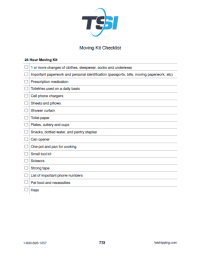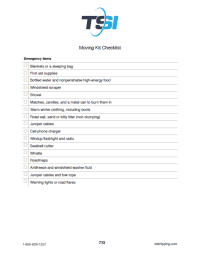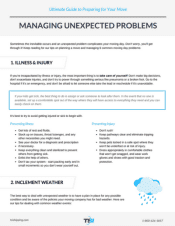You've made a detailed moving timeline, you bought insurance, and you've done everything you can to get ready for moving day, but sometimes the inevitable occurs and an unexpected problem complicates your moving day. It can be frustrating, especially on such a monumental day, but don’t worry, you’ll get through it!
Keep reading for our tips on planning a move and managing 6 common moving day problems:
|
Jump to: |
1. Illness & Injury
You’re all set for your move, then suddenly you start sneezing, your temperature rises, and it becomes clear: you’re sick. So sick, in fact, that you won’t be able to assist with your move. Or maybe, in all the chaos and disarray in your home, you take a misstep or lift a box incorrectly, and now you can’t carry anything because you threw out your back or broke a bone. Whether you’ve got a simple cold or are stuck in a cast, illness and injury can seriously derail your moving plans.
What can you do?
If you’re incapacitated by illness or injury, you may be wondering what your options are aside from rescheduling. First and foremost, the most important thing is to take care of yourself! Don’t make big decisions, don’t exacerbate injuries, and whatever you do, don’t try to power through something serious like pneumonia or a broken foot. Go to the hospital if it’s an emergency. It doesn’t help anyone if you make your ailments worse, and there’s nothing wrong with letting someone else take the lead or rescheduling if it’s unavoidable! When you’re not at your best, having someone whose brain isn’t fogged up by the flu look over the paperwork, sign-off, and generally coordinate the move is not only allowed, it’s advisable.
| If your kids get sick, the best thing to do is assign or ask someone to look after them. Grandparents, friends and close neighbors are all good people to ask for help. In the event that no one is available, set up a comfortable spot out of the way where they will have access to everything they need and you can easily check on them. |
The easiest solution is to try to avoid getting injured or sick to begin with. If you notice yourself starting to feel run down and under the weather in the weeks or days before your move, immediately take action:
- Get lots of rest and fluids.
- Stock up on tissues, throat lozenges, and any other necessities you might need.
- Take a trip to the doctor for a diagnosis and prescription if necessary.
- Keep everything clean and sterilized to prevent others from getting sick.
- Enlist the help of others.
- Don’t tax your system - start packing early and in small increments so you don’t wear yourself out.
Got a slight case of the sniffles? If you’re feeling up for it, you can continue as planned. Just remember to stay hydrated and take breaks regularly. Let others do the heavy lifting and don’t feel bad if you have to step away for a short nap.
On the other hand, avoiding injuries is easy as long as you don’t rush - just remember to:
- Keep pathways clear and eliminate tripping hazards.
- Keep pets locked in a safe spot where they won’t be underfoot or at risk of injury.
- Dress appropriately in comfortable clothes that won’t get snagged, and wear work gloves and shoes with good traction and protection.
In either case, it’s a good idea to keep a suitcase or a box of things you will need within the first 24 hours of moving, so that if you’re unable to unpack, you will still have quick access to the essentials. And, when in doubt, stay out of the way and let the professionals handle things.

2. Inclement & Inconvenient Weather
Nothing can blindside planning a move like bad weather - we all know how unpredictable it can be! Even if you check the forecast every day leading up to the move and everything seems fine - an unexpected storm can easily pop up on the day of your move. Unless it’s an extreme weather event like a tornado or hurricane, you’ll likely want to press forward with your move.
The best way to deal with unexpected weather is to have a plan in place for any possible condition and be aware of what kind of policies your moving company has for bad weather. Here are our tips for dealing with common weather events:
Extreme Temperatures
Cold temperatures may seem like the only issue here; after all, who wants to move when you’re risking frostbite every time you step outside? But temperature can be just as unsafe in the summer months. It might seem ideal to be moving on a bright and sunny day, but that isn’t always the case. Once the summer sun starts shining, it can become unbearably hot and even unsafe quicker than you might expect.
If it is extremely hot or extremely cold to the point that there is an advisory in effect, you might be looking at a plan to reschedule. Otherwise, it’s important to make sure everyone is taking action to stay safe, as well as to keep your belongings protected. After all, extreme temperatures can damage sensitive items, too.
Intense heat can cause heat stroke, sun burns, dehydration, hyperthermia, and exhaustion. If it’s not so hot that you need to reschedule, just remember:
- Stay hydrated
- Wear sunscreen
- Dress in light-colored, lightweight clothing and layers
- Take breaks regularly
- Stay out of the sun when possible
- Move large and heavy items early in the day before the sun and temperature rise
- Keep temperature-sensitive items inside of vehicles with environmental controls
Freezing cold temperatures can cause frostbite and hypothermia. If the temperature is so cold that people are at risk of frostbite within minutes of stepping outside, reschedule your move. Otherwise:
- Check your car battery and make sure it is charged.
- Keep an emergency kit in your vehicle.
- Dress in layers
- Keep your feet, hands, and ears covered up and warm
- Have warm drinks on hand
- Keep temperature-sensitive items inside of vehicles with environmental controls
Ice & Snow
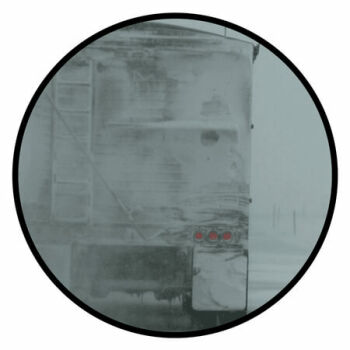
Ice and snow on moving day can be an accident waiting to happen. Roads and walkways become extremely slippery, and snow-packed roads are both unsafe to drive on and difficult to traverse. You can easily plow and salt your own driveway, but if conditions are severe, the highways and roads may not be safe. If you feel confident enough to continue your move, or have no other option:
- Shovel and salt all walkways and your driveway.
- Dress in layers.
- Keep your feet, hands, and ears covered up and warm.
- Have warm drinks on hand.
- Keep temperature-sensitive items well-wrapped or place them inside vehicles with environmental controls.
- Keep an emergency kit in your vehicle.
- Before leaving, check weather and traffic reports so you can avoid dangerous areas and accidents.
- Drive slowly and carefully.
- Leave space between your car and the vehicle in front of you.
|
Your emergency kit can also can serve double as an emergency kit for your new house, since you won’t be unpacked and settled right away. It should include:
|
Fog
Fog can hinder your moving plans by decreasing visibility to no more than a foot in front of you, making driving impossible and carrying items in and out of your home dangerous. If it’s an early morning fog, the sun will typically burn it off as it rises and you can resume your move as planned.
Otherwise, work with your moving company to set up an alternate moving date. If you’re still set on moving, make sure to:
- Wrap items to prevent damage from moisture.
- Be patient.
- Drive slowly and carefully.
- Employ all the safety options your vehicle is equipped with, such as fog lights or low beams, windshield wipers, and environmental controls.
- Try to avoid low-lying areas where fog will be more dense.
- Be mindful of animals and other vehicles on the road and be prepared to stop quickly.
- Leave extra space between your vehicle and the car in front of you.
Rain
Moving in the rain, while inconvenient, is not impossible. Keep these tips in mind:
- Check the weather report - some showers pass through very quickly, and you may be better off waiting 20 minutes for the weather to pass.
- To avoid slips and falls, wear shoes with good grip and put carpets, tarps, or towels down on the floor of your home.
- Cover loose items and cardboard boxes with tarps or plastic bags to prevent water damage.

Thunderstorms
Some storms pass quickly, but if you only have a short window and it doesn’t look like it’s going to let up anytime soon, your best bet might be to reschedule your move. Otherwise, waiting until the storm breaks up is the only solution - torrential rain, hail, lightning, and strong winds can make moving extremely dangerous and damage your items. After you think it’s safe to start, remember these rules while moving in the rain:
- Wear shoes with a good grip and put carpets or towels down on the floor of your home (old and/or new).
- Cover loose items and cardboard boxes with plastic bags to prevent water damage.
3. Terrible Traffic
Movers have a lot of experience with driving, and many have access to GPS data that can help them find the quickest way to your new home and avoid traffic jams. If you’re managing your own move, you may want to invest in a GPS system and plan more than one route to your new place in the event that there is a traffic jam or an accident on the way. It’s good to keep in mind that even with this technology, you’ll likely encounter some traffic along the way, so try not to stress out about it. It’s inconvenient, but the traffic will clear and your move will continue as planned.
| PRO TIP: As tempting as it is, don’t move on a Friday. Traffic is often worse, especially in the summer, and many people prefer to move on this day because it gives them a few days to unpack without missing work. |
Accidents & Breakdowns
In the event that it’s your actual moving truck that breaks down or is involved in an accident, you’ll have to wait for a new truck to arrive and your items will have to be transferred to another vehicle. There is little you can do to avoid this scenario when planning a move, but there are actions you can take to limit the damage:
- Select a reputable moving company that has a protocol in place for these types of situations.
- Familiarize yourself with what the protocol is and what will happen to your stuff.
4. Issues with Your New House
Unexpected issues can pop up once you arrive at your new home as well. Most of them will have simple solutions and are easy to prepare for:
- Have the contact information of your utility providers on hand in case there’s an issue with your electricity or gas, or if you forgot to have it connected. If you explain your situation to them, they should make connecting your utilities a priority, but it isn’t always possible.
- In the event that you’ll need to go a few days without electricity or water, keep an emergency kit that contains candles, flashlights, water, and nonperishable food items.
- Have the number of local handyman or your landlord in case there is an emergency with your new home.
- Keep some essential supplies readily available in case you run into snags or need to check into a hotel. Download our free printable Emergency Moving Kit and Essential Moving Day Items checklists below.
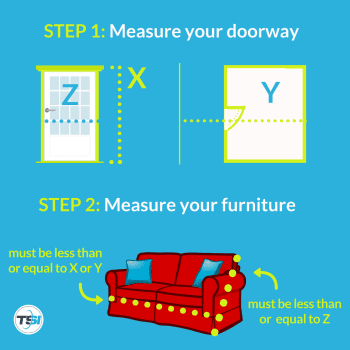
Other issues can require more effort. For instance, what if your furniture won’t fit through the door? Here’s what to do:
- Check if your furniture can be dismantled. If it can, all you have to do is take it apart and rebuild it inside your house. If it can’t be dismantled, you’ll need to find another way in, such as through the window.
- Measure all entryways and windows when you first start planning a move, even the second floor, to see if you can fit the item inside your house. This step may require hiring professional movers if you haven’t done so already. The graphic to the left shows you how to measure your furniture to make sure it can fit through your door.
- If it just isn’t possible, you’ll need to store the item in your garage or find a local storage facility until you can figure out what to do with it.
Parking can be another major issue when moving, especially into an apartment building or a house with no driveway. This can be inconvenient under the best of conditions, but if you’re working with professional movers it may even cost you! Hauling items from an inconvenient distance can result in a long carry fee. Here’s how to avoid it:
- Know the parking situation before you move and plan your move accordingly.
- If your new home or apartment doesn’t have a driveway or designated parking area for moving vans or trucks, reserve a parking space in a nearby lot.
- Talk to your neighbors about the parking situation and work it out with them. Many people will be understanding, having gone through a move themselves.
5. Bad Movers
There are several factors that can make for bad movers: they're inconsiderate or incompetent, they’re inexperienced or - worst of all - they're flat out scam artists. Bad movers can result in unnecessary delays, damaged items and property, emotional stress, and in the case of scam artists, even having your belongings held hostage until you pay an additional fee that was not part of the initial agreement.
The best way to deal with this frustrating scenario is to avoid it entirely. Follow these tips to make sure you book with a reputable moving company:
- Research moving companies carefully before making your selection, ensuring that they are licensed, experienced professionals.
- Read reviews - it's easy to get a feel for how well a company performs based on the experience of other customers, but remember to check more than one site and read with a critical eye. Some disreputable moving companies pay for fake positive reviews.
- Be skeptical of extremely low bids and avoid bids based on cubic footage rather than weight. This practice is illegal, and is often a good indication that this is not a reliable company.
- Get insurance - even after you've done the research, it never hurts to have a backup plan.
If you've already found yourself the victim of a moving scam, there are a few things that you can do:
- If the company has broken any laws, such as holding your stuff hostage (this is actually theft), local law enforcement can get involved and help you resolve the issue.
- Check out MoveRescue.com for more tips and advice.
6. Damaged or Missing Items
What do you do if you’ve started unpacking and discover a damaged item, or you’ve just finished and you have that sinking feeling that something is missing? This can be especially complicated if you’ve moved to a different city or state. There are several steps you can take before, during, and after your move to make resolving the issue of a damaged or lost item easier.
Before
- Take an inventory of all of your items while you pack. If you’ve hired a moving company, they will often do this for you, but it doesn’t hurt to keep or make one of your own.
- If you are getting rid of items to lighten the load, keep an inventory of them as well. It’s easy to forget in the chaos of a move that you have actually given something away rather than misplaced it.
- Make note of any existing damage and take pictures of important or fragile items so you have an image to compare or show in the event it goes missing or gets damaged.
- Carefully wrap, package, seal and label fragile items.
- Pack one room at a time and label the boxes with their location and contents.
- Do a few sweeps of the house after everything has been packed up to ensure that nothing is being left behind.
During
- Keep your most important documents and possessions with you during the move.
- Check the truck personally to ensure all of the boxes have been unloaded.
- Number your boxes and don’t sign for them until after you’ve verified their delivery.
After
At this point, which course of action you take depends on what has happened to the item. If your item was lost or broken by a moving company, any reputable mover will take action immediately to help you recover the item or, if the original terms of agreement included moving insurance or compensation, cover the cost of the item or its repair.
If you acquired insurance independently, you will need to contact them separately.
Damaged items should be photographed and documented. If you can, determine the cause of damage.
For missing items, take the following steps:
- Double check that it isn’t still packed or that you haven’t accidentally placed it in the wrong box or room.
- Gather a detailed description and images (where possible) of the item.
- If you utilized a professional moving service, file a claim with the company providing the description and images. If you moved with the help of friends and family, share the description and image with them so they can search their vehicles and homes for the item.
Download our Printable Moving Day Checklists
Be prepared for anything on your moving day. Download and print off our moving day checklists and make sure you have everything handy:
|
Essential Moving Day Items Checklist |
|
Emergency Moving Checklist |
Download our Printable GuideClick to download (PDF)
Download the complete printable Ultimate Guide to Preparing for Your Move. |
Keep Reading the Ultimate Guide to Preparing for Your MovePart 1: Budgeting for Your Move Part 7: Moving Large, Heavy, or Bulky Items |

